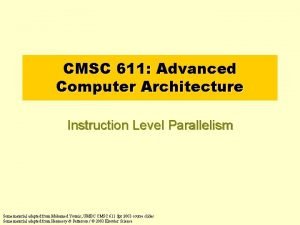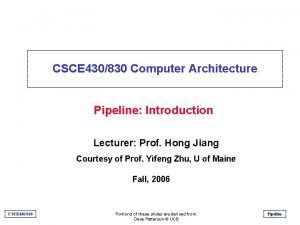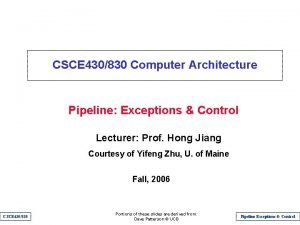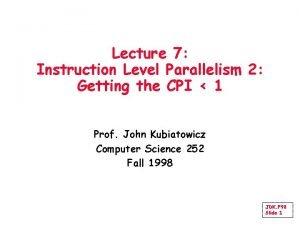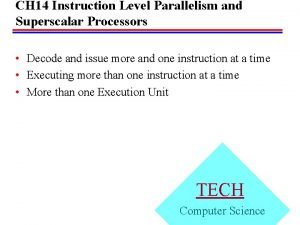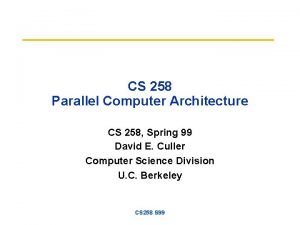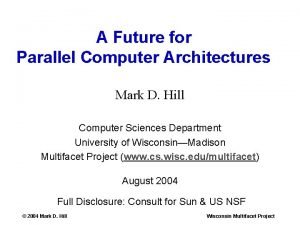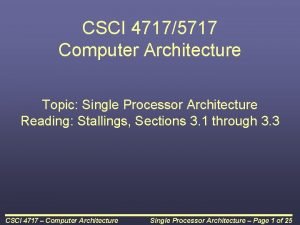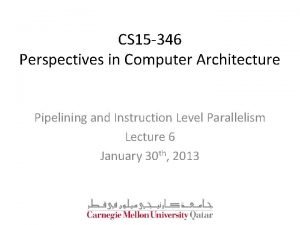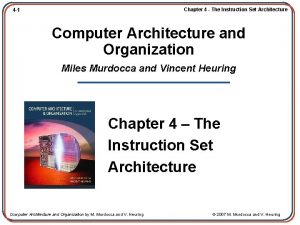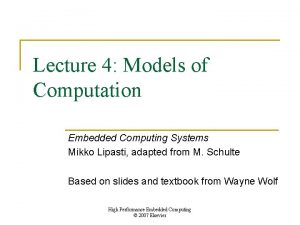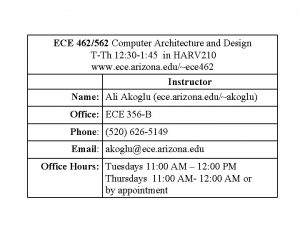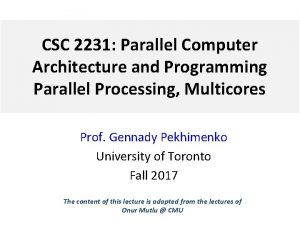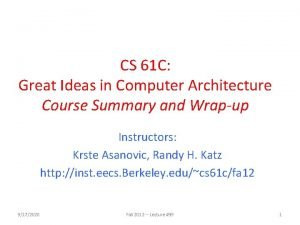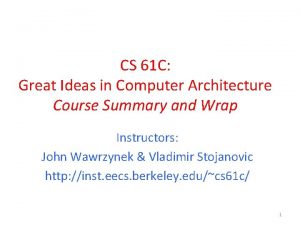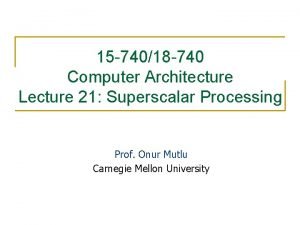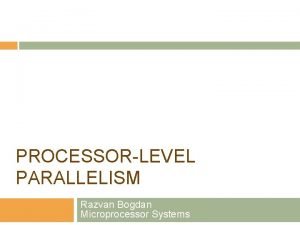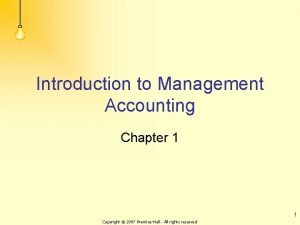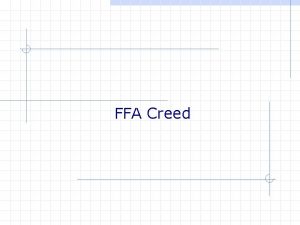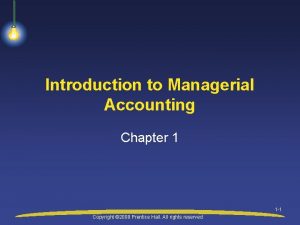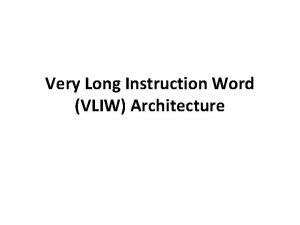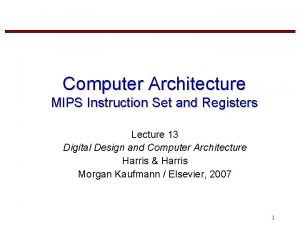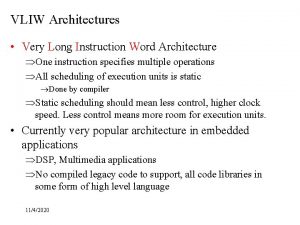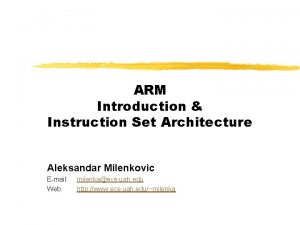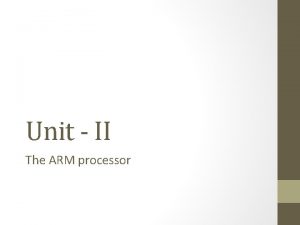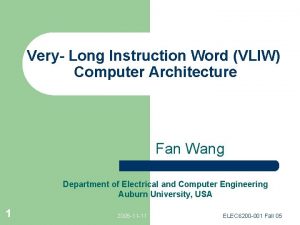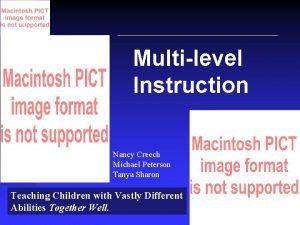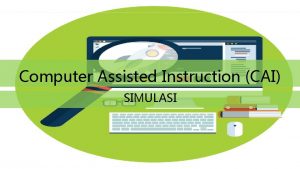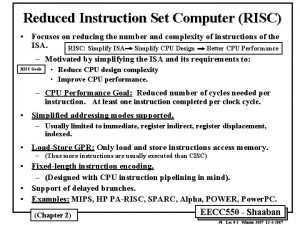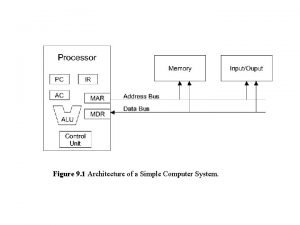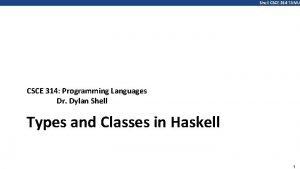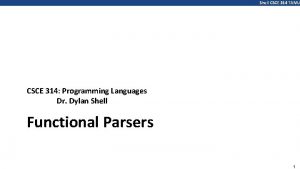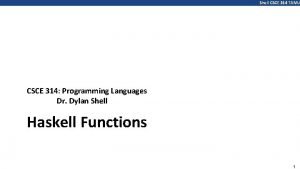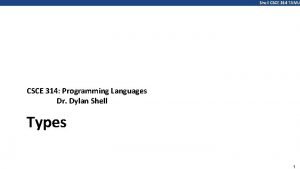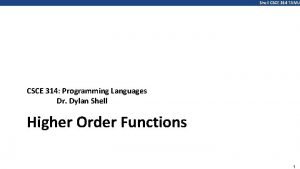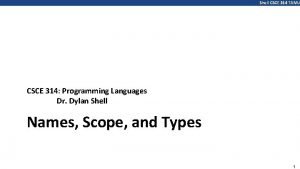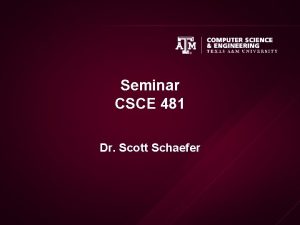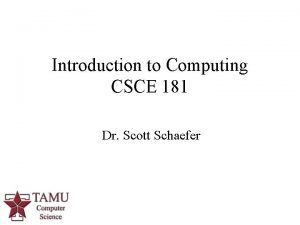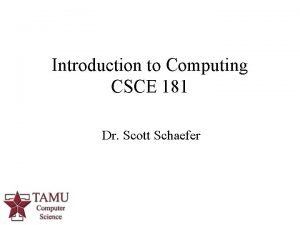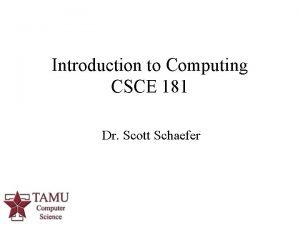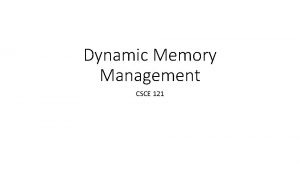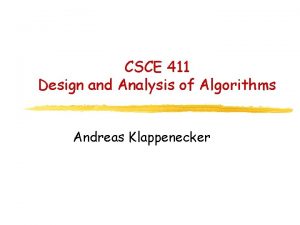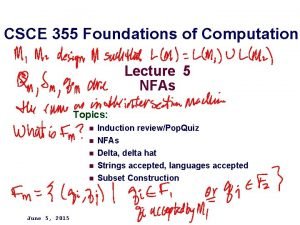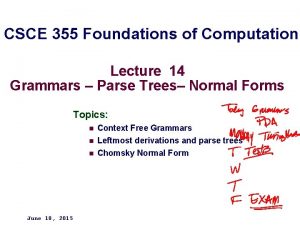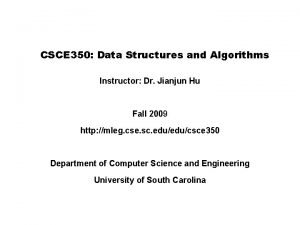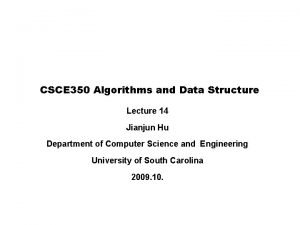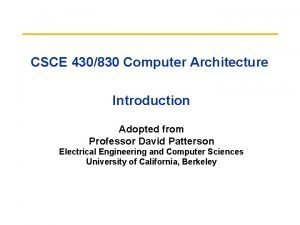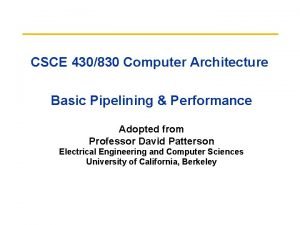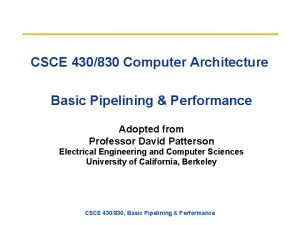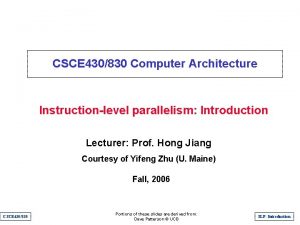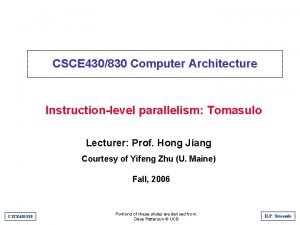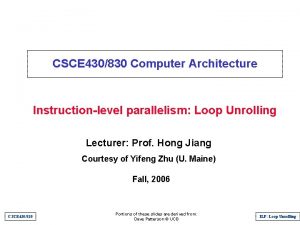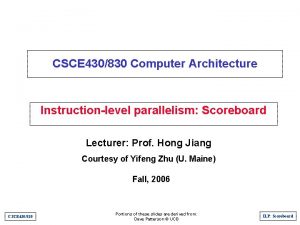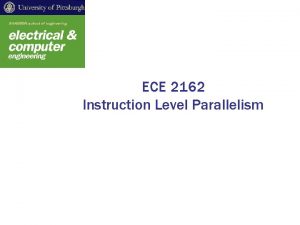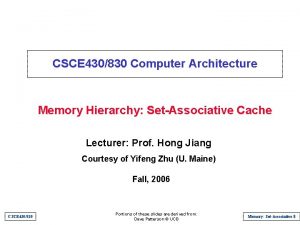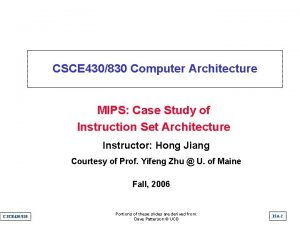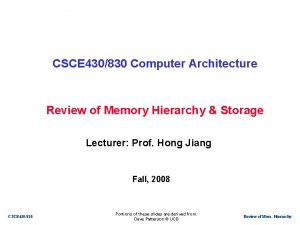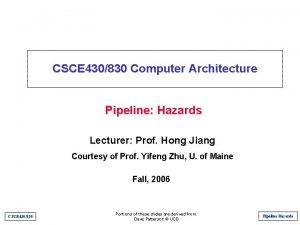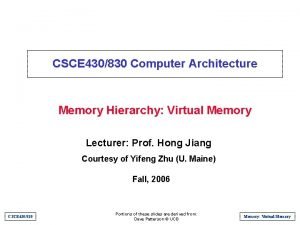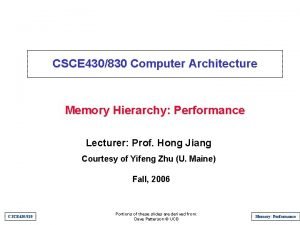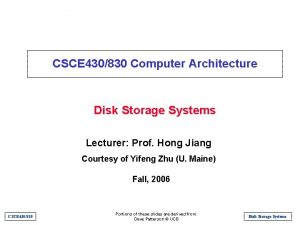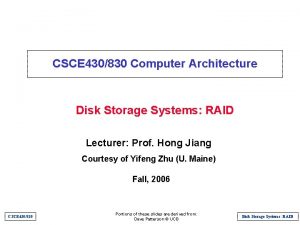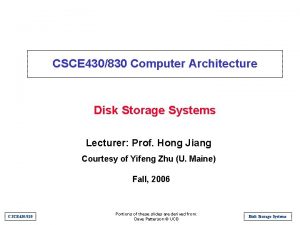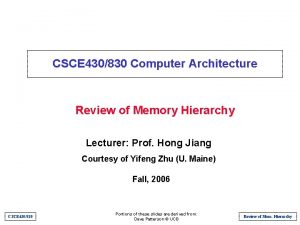CSCE 430830 Computer Architecture Instruction Level Parallelism Adopted












































































- Slides: 76

CSCE 430/830 Computer Architecture Instruction Level Parallelism Adopted from Professor David Patterson Electrical Engineering and Computer Sciences University of California, Berkeley

Outline • • • ILP Compiler techniques to increase ILP Loop Unrolling Static Branch Prediction Dynamic Branch Prediction Overcoming Data Hazards with Dynamic Scheduling • (Start) Tomasulo Algorithm • Conclusion 12/6/2020 CSCE 430/830, Instruction Level Parallelism 2

Recall from Pipelining Review • Pipeline CPI = Ideal pipeline CPI + Structural Stalls + Data Hazard Stalls + Control Stalls – Ideal pipeline CPI: measure of the maximum performance attainable by the implementation – Structural hazards: HW cannot support this combination of instructions – Data hazards: Instruction depends on result of prior instruction still in the pipeline – Control hazards: Caused by delay between the fetching of instructions and decisions about changes in control flow (branches and jumps) 12/6/2020 CSCE 430/830, Instruction Level Parallelism 3

Instruction Level Parallelism • • Instruction-Level Parallelism (ILP): overlap the execution of instructions to improve performance 2 approaches to exploit ILP: 1) Rely on hardware to help discover and exploit the parallelism dynamically (e. g. , Pentium 4, AMD Opteron, IBM Power) , and 2) Rely on software technology to find parallelism, statically at compile-time (e. g. , Itanium 2) • Next several lectures on this topic 12/6/2020 CSCE 430/830, Instruction Level Parallelism 4

Instruction-Level Parallelism (ILP) • Basic Block (BB) ILP is quite small – BB: a straight-line code sequence with no branches in except to the entry and no branches out except at the exit – average dynamic branch frequency 15% to 25% => 4 to 7 instructions execute between a pair of branches – Plus instructions in BB likely to depend on each other • To obtain substantial performance enhancements, we must exploit ILP across multiple basic blocks • Simplest: loop-level parallelism to exploit parallelism among iterations of a loop. E. g. , for (i=1; i<=1000; i=i+1) x[i] = x[i] + y[i]; 12/6/2020 CSCE 430/830, Instruction Level Parallelism 5

Loop-Level Parallelism • Exploit loop-level parallelism by “unrolling loop” either by 1. dynamic via branch prediction or 2. static via loop unrolling by compiler Determining instruction dependence is critical to Loop Level Parallelism • If 2 instructions are – parallel, they can execute simultaneously in a pipeline of arbitrary depth without causing any stalls (assuming no structural hazards) – dependent, they are not parallel and must be executed in order, although they may often be partially overlapped 12/6/2020 CSCE 430/830, Instruction Level Parallelism 6

Data Dependence and Hazards • Instr. J is data dependent (aka true dependence) on Instr. I: 1. Instr. J tries to read operand before Instr. I writes it I: add r 1, r 2, r 3 J: sub r 4, r 1, r 3 2. or Instr. J is data dependent on Instr. K which is dependent on Instr. I • • • If two instructions are data dependent, they cannot execute simultaneously or be completely overlapped Data dependence in instruction sequence data dependence in source code effect of original data dependence must be preserved If data dependence caused a hazard in pipeline, called a Read After Write (RAW) hazard 12/6/2020 CSCE 430/830, Instruction Level Parallelism 7

ILP and Data Dependencies, Hazards • HW/SW must preserve program order: order instructions would execute in if executed sequentially as determined by original source program – Dependences are a property of programs • Presence of dependence indicates potential for a hazard, but actual hazard and length of any stall is property of the pipeline • Importance of the data dependencies 1) indicates the possibility of a hazard 2) determines order in which results must be calculated 3) sets an upper bound on how much parallelism can possibly be exploited • HW/SW goal: exploit parallelism by preserving program order only where it affects the outcome of the program 12/6/2020 CSCE 430/830, Instruction Level Parallelism 8

Name Dependence #1: Anti-dependence • Name dependence: when 2 instructions use same register or memory location, called a name, but no flow of data between the instructions associated with that name; 2 versions of name dependence • Instr. J writes operand before Instr. I reads it I: sub r 4, r 1, r 3 J: add r 1, r 2, r 3 K: mul r 6, r 1, r 7 Called an “anti-dependence” by compiler writers. This results from reuse of the name “r 1” • If anti-dependence caused a hazard in the pipeline, called a Write After Read (WAR) hazard 12/6/2020 CSCE 430/830, Instruction Level Parallelism 9

Name Dependence #2: Output dependence • Instr. J writes operand before Instr. I writes it. I: sub r 1, r 4, r 3 J: add r 1, r 2, r 3 K: mul r 6, r 1, r 7 • Called an “output dependence” by compiler writers This also results from the reuse of name “r 1” • If anti-dependence caused a hazard in the pipeline, called a Write After Write (WAW) hazard • Instructions involved in a name dependence can execute simultaneously if name used in instructions is changed so instructions do not conflict – Register renaming resolves name dependence for regs – Either by compiler or by HW 12/6/2020 CSCE 430/830, Instruction Level Parallelism 10

Control Dependencies • Every instruction is control dependent on some set of branches, and, in general, these control dependencies must be preserved to preserve program order if p 1 { S 1; }; if p 2 { S 2; } • S 1 is control dependent on p 1, and S 2 is control dependent on p 2 but not on p 1. 12/6/2020 CSCE 430/830, Instruction Level Parallelism 11

Control Dependence Ignored • Control dependence need not be preserved – willing to execute instructions that should not have been executed, thereby violating the control dependences, if can do so without affecting correctness of the program • Instead, 2 properties critical to program correctness are 1) exception behavior and 2) data flow 12/6/2020 CSCE 430/830, Instruction Level Parallelism 12

Exception Behavior • Preserving exception behavior any changes in instruction execution order must not change how exceptions are raised in program ( no new exceptions) • Example: DADDU R 2, R 3, R 4 BEQZ R 2, L 1 LW R 1, 0(R 2) L 1: – (Assume branches not delayed) • Problem with moving LW before BEQZ? 12/6/2020 CSCE 430/830, Instruction Level Parallelism 13

Data Flow • Data flow: actual flow of data values among instructions that produce results and those that consume them – branches make flow dynamic, determine which instruction is supplier of data • Example: DADDU R 1, R 2, R 3 BEQZ R 4, L DSUBU R 1, R 5, R 6 L: … OR R 7, R 1, R 8 • OR depends on DADDU or DSUBU? Must preserve data flow on execution 12/6/2020 CSCE 430/830, Instruction Level Parallelism 14

Outline • • • ILP Compiler techniques to increase ILP Loop Unrolling Static Branch Prediction Dynamic Branch Prediction Overcoming Data Hazards with Dynamic Scheduling • (Start) Tomasulo Algorithm • Conclusion 12/6/2020 CSCE 430/830, Instruction Level Parallelism 15

Software Techniques - Example • This code, add a scalar to a vector: for (i=1000; i>0; i=i– 1) x[i] = x[i] + s; • Assume following latencies for all examples – Ignore delayed branch in these examples Instruction producing result FP ALU op Load double Integer op 12/6/2020 Instruction using result Another FP ALU op Store double Integer op Delay (distance) in cycles 4 3 2 1 1 CSCE 430/830, Instruction Level Parallelism Latency (stalls between) in cycles 3 2 1 0 0 16

FP Loop: Where are the Hazards? • First translate into MIPS code: -To simplify, assume 8 is lowest address Loop: L. D ADD. D S. D DADDUI BNEZ 12/6/2020 F 0, 0(R 1) ; F 0=vector element F 4, F 0, F 2 ; add scalar from F 2 0(R 1), F 4 ; store result R 1, -8 ; decrement pointer 8 B (DW) R 1, Loop ; branch R 1!=zero CSCE 430/830, Instruction Level Parallelism 17

FP Loop Showing Stalls 1 Loop: L. D 2 stall 3 ADD. D 4 stall 5 stall 6 S. D 7 DADDUI 8 stall 9 BNEZ Instruction producing result FP ALU op Load double • F 0, 0(R 1) ; F 0=vector element F 4, F 0, F 2 ; add scalar in F 2 0(R 1), F 4 ; store result R 1, -8 ; decrement pointer 8 B (DW) ; assumes can’t forward to branch R 1, Loop ; branch R 1!=zero Instruction using result Another FP ALU op Store double FP ALU op Latency in clock cycles 3 2 1 9 clock cycles: Rewrite code to minimize stalls? 12/6/2020 CSCE 430/830, Instruction Level Parallelism 18

Revised FP Loop Minimizing Stalls 1 Loop: L. D F 0, 0(R 1) 2 DADDUI R 1, -8 3 ADD. D F 4, F 0, F 2 4 stall 5 stall 6 7 S. D 8(R 1), F 4 BNEZ R 1, Loop ; altered offset when move DSUBUI Swap DADDUI and S. D by changing address of S. D Instruction producing result FP ALU op Load double Instruction using result Another FP ALU op Store double FP ALU op Latency in clock cycles 3 2 1 7 clock cycles, but just 3 for execution (L. D, ADD. D, S. D), 4 for loop overhead; How make faster? 12/6/2020 CSCE 430/830, Instruction Level Parallelism 19

Unroll Loop Four Times (straightforward way) 1 Loop: L. D 3 ADD. D 6 S. D 7 L. D 9 ADD. D 12 S. D 13 L. D 15 ADD. D 18 S. D 19 L. D 21 ADD. D 24 S. D 25 DADDUI 26 BNEZ F 0, 0(R 1) F 4, F 0, F 2 0(R 1), F 4 F 6, -8(R 1) F 8, F 6, F 2 -8(R 1), F 8 F 10, -16(R 1) F 12, F 10, F 2 -16(R 1), F 12 F 14, -24(R 1) F 16, F 14, F 2 -24(R 1), F 16 R 1, #-32 R 1, LOOP 1 cycle stall Rewrite loop to stalls? 2 cycles stall minimize ; drop DSUBUI & BNEZ ; alter to 4*8 27 clock cycles, or 6. 75 per iteration (Assumes R 1 is multiple of 4) 12/6/2020 CSCE 430/830, Instruction Level Parallelism 20

Unrolled Loop Detail • Do not usually know upper bound of loop • Suppose it is n, and we would like to unroll the loop to make k copies of the body • Instead of a single unrolled loop, we generate a pair of consecutive loops: – 1 st executes (n mod k) times and has a body that is the original loop – 2 nd is the unrolled body surrounded by an outer loop that iterates (n/k) times • For large values of n, most of the execution time will be spent in the unrolled loop 12/6/2020 CSCE 430/830, Instruction Level Parallelism 21

Unrolled Loop That Minimizes Stalls 1 Loop: L. D F 0, 0(R 1) 2 L. D F 6, -8(R 1) 3 L. D F 10, -16(R 1) 4 L. D F 14, -24(R 1) 5 ADD. D F 4, F 0, F 2 6 ADD. D F 8, F 6, F 2 7 ADD. D F 12, F 10, F 2 8 ADD. D F 16, F 14, F 2 9 S. D 0(R 1), F 4 10 S. D -8(R 1), F 8 11 S. D -16(R 1), F 12 12 DSUBUI R 1, #32 13 S. D 8(R 1), F 16 ; 8 -32 = -24 14 BNEZ R 1, LOOP 14 clock cycles, or 3. 5 per iteration 12/6/2020 CSCE 430/830, Instruction Level Parallelism 22

5 Loop Unrolling Decisions • 1. 2. 3. 4. Requires understanding how one instruction depends on another and how the instructions can be changed or reordered given the dependences: Determine loop unrolling useful by finding that loop iterations were independent (except for maintenance code) Use different registers to avoid unnecessary constraints forced by using same registers for different computations Eliminate the extra test and branch instructions and adjust the loop termination and iteration code Determine that loads and stores in unrolled loop can be interchanged by observing that loads and stores from different iterations are independent • Transformation requires analyzing memory addresses and finding that they do not refer to the same address 5. Schedule the code, preserving any dependences needed to yield the same result as the original code 12/6/2020 CSCE 430/830, Instruction Level Parallelism 23

In-class Exercise • Identify data hazards in the code below: – MULTD – ADDD – SD F 3, F 4, F 2, F 6, F 1 F 2, 0(F 3) • For each of the following code fragments, identify each type of dependence that a compiler will find (a fragment may have no dependences) and whether a compiler could schedule the two instructions (i. e. , change their orders). 1. DADDI R 1, #4 LD R 2, 7(R 1) 3. SD R 2, 7(R 1) SD F 2, 200(R 7) 12/6/2020 2. DADD R 3, R 1, R 2 SD R 2, 7(R 1) 4. BEZ R 1, place SD R 1, 7(R 1) CSCE 430/830, Instruction Level Parallelism 24

3 Limits to Loop Unrolling 1. Decrease in amount of overhead amortized with each extra unrolling • Amdahl’s Law 2. Growth in code size • For larger loops, it increases the instruction cache miss rate 3. Register pressure: potential shortfall in registers created by aggressive unrolling and scheduling • • If not possible to allocate all live values to registers, may lose some or all of its advantage Loop unrolling reduces impact of branches on pipeline; another way is branch prediction 12/6/2020 CSCE 430/830, Instruction Level Parallelism 25

Static Branch Prediction • Lecture from last week showed scheduling code around delayed branch • To reorder code around branches, need to predict branch statically when compile • Simplest scheme is to predict a branch as taken – Average misprediction = untaken branch frequency = 34% SPEC • More accurate scheme predicts branches using profile information collected from earlier runs, and modify prediction based on last run: 12/6/2020 CSCE 430/830, Instruction Level Parallelism Integer Floating Point 26

Dynamic Branch Prediction • Why does prediction work? – Underlying algorithm has regularities – Data that is being operated on has regularities – Instruction sequence has redundancies that are artifacts of way that humans/compilers think about problems • Is dynamic branch prediction better than static branch prediction? – Seems to be – There a small number of important branches in programs which have dynamic behavior 12/6/2020 CSCE 430/830, Instruction Level Parallelism 27

Dynamic Branch Prediction • Performance = ƒ(accuracy, cost of misprediction) • Branch History Table: Lower bits of PC address index table of 1 -bit values – Says whether or not branch taken last time – No address check • Problem: in a loop, 1 -bit BHT will cause two mispredictions (avg is 9 iterations before exit): – End of loop case, when it exits instead of looping as before – First time through loop on next time through code, when it predicts exit instead of looping 12/6/2020 CSCE 430/830, Instruction Level Parallelism 28

Dynamic Branch Prediction • Solution: 2 -bit scheme where change prediction only if get misprediction twice T NT Predict Taken T Predict Not Taken T NT T Predict Taken NT Predict Not Taken NT • Red: stop, not taken • Green: go, taken • Adds hysteresis to decision making process 12/6/2020 CSCE 430/830, Instruction Level Parallelism 29

BHT Accuracy • Mispredict because either: – Wrong guess for that branch – Got branch history of wrong branch when index the table • 4096 entry table: Integer 12/6/2020 Floating Point CSCE 430/830, Instruction Level Parallelism 30

Correlated Branch Prediction • Idea: record m most recently executed branches as taken or not taken, and use that pattern to select the proper n-bit branch history table • In general, a (m, n) predictor means recording last m branches to select between 2 m history tables, each with n-bit counters – Thus, old 2 -bit BHT is a (0, 2) predictor • Global Branch History: m-bit shift register keeping T/NT status of last m branches. • Each entry in table has 2 m n-bit predictors. 12/6/2020 CSCE 430/830, Instruction Level Parallelism 31

Correlating Branches Branch address (2, 2) predictor – Behavior of recent branches selects between four predictions of next branch, updating just that prediction 4 2 -bits per branch predictor Prediction 2 -bit global branch history 12/6/2020 CSCE 430/830, Instruction Level Parallelism 32

Accuracy of Different Schemes 4096 Entries 2 -bit BHT Unlimited Entries 2 -bit BHT 1024 Entries (2, 2) BHT 18% 16% 14% 12% 11% 10% 8% 6% 6% 5% 6% 6% 4, 096 entries: 2 -bits per entry 12/6/2020 Unlimited entries: 2 -bits/entry CSCE 430/830, Instruction Level Parallelism li eqntott expresso gcc fpppp matrix 300 0% spice 1% doducd 1% tomcatv 2% 0% 5% 4% 4% nasa 7 Frequency of Mispredictions 20% 1, 024 entries (2, 2) 33

Tournament Predictors • Multilevel branch predictor • Use n-bit saturating counter to choose between predictors • Usual choice between global and local predictors P 1/P 2 ={0, 1}/{0, 1} 0: prediction incorrect 1: prediction correct 12/6/2020 CSCE 430/830, Instruction Level Parallelism 34

Tournament Predictors Tournament predictor using, say, 4 K 2 -bit counters indexed by local branch address. Chooses between: • Global predictor – 4 K entries index by history of last 12 branches (212 = 4 K) – Each entry is a standard 2 -bit predictor • Local predictor – Local history table: 1024 10 -bit entries recording last 10 branches, index by branch address – The pattern of the last 10 occurrences of that particular branch used to index table of 1 K entries with 3 -bit saturating counters 12/6/2020 CSCE 430/830, Instruction Level Parallelism 35

Comparing Predictors (Fig. 2. 8) • Advantage of tournament predictor is ability to select the right predictor for a particular branch – Particularly crucial for integer benchmarks. – A typical tournament predictor will select the global predictor almost 40% of the time for the SPEC integer benchmarks and less than 15% of the time for the SPEC FP benchmarks 12/6/2020 CSCE 430/830, Instruction Level Parallelism 36

Pentium 4 Misprediction Rate (per 1000 instructions, not per branch) 6% misprediction rate per branch SPECint (19% of INT instructions are branch) 2% misprediction rate per branch SPECfp (5% of FP instructions are branch) SPECint 2000 12/6/2020 SPECfp 2000 CSCE 430/830, Instruction Level Parallelism 37

Branch Target Buffers (BTB) • Branch target calculation is costly and stalls the instruction fetch. • BTB stores PCs the same way as caches • The PC of a branch is sent to the BTB • When a match is found the corresponding Predicted PC is returned • If the branch was predicted taken, instruction fetch continues at the returned predicted PC

Branch Target Buffers Branch target folding: for unconditional branches store the target instructions themselves in the buffer!

Dynamic Branch Prediction Summary • Prediction becoming important part of execution • Branch History Table: 2 bits for loop accuracy • Correlation: Recently executed branches correlated with next branch – Either different branches (GA) – Or different executions of same branches (PA) • Tournament predictors take insight to next level, by using multiple predictors – usually one based on global information and one based on local information, and combining them with a selector – In 2006, tournament predictors using 30 K bits are in processors like the Power 5 and Pentium 4 • Branch Target Buffer: include branch address & prediction; • Branch target folding. 12/6/2020 CSCE 430/830, Instruction Level Parallelism 40

In-Class Exercise • Given a deeply pipelined processor and a branch-target buffer for conditional branches only, assuming a misprediction penalty of 4 cycles and a buffer miss penalty of 3 cycles, 90% hit rate and 90% accuracy, and 15% branch frequency. How much faster is the processor with the BTB vs. a processor that has a fixed 2 -cycle branch penalty? • Speedup = CPIno. BTB /CPIBTB • = (CPIbase + Stallsno. BTB )/(CPIbase + Stalls. BTB ) • Stalls = ∑ Frequency x Penalty • Stallsno. BTB = 15% x 2 = 0. 30 • Stalls. BTB = Stallsmiss-BTB + Stallshit-BTB-correct + Stallshit-BTB-wrong = 15%x 10%x 3 + 15%x 90%x 0 +15%x 90%x 10%x 4 • • = 0. 097 • Speedup = (1 + 0. 3) / (1 + 0. 097) = 1. 2 12/6/2020 CSCE 430/830, Instruction Level Parallelism 41

Outline • • • ILP Compiler techniques to increase ILP Loop Unrolling Static Branch Prediction Dynamic Branch Prediction Overcoming Data Hazards with Dynamic Scheduling • (Start) Tomasulo Algorithm • Conclusion 12/6/2020 CSCE 430/830, Instruction Level Parallelism 42

Advantages of Dynamic Scheduling • Dynamic scheduling - hardware rearranges the instruction execution to reduce stalls while maintaining data flow and exception behavior • It handles cases when dependences unknown at compile time – it allows the processor to tolerate unpredictable delays such as cache misses, by executing other code while waiting for the miss to resolve • It allows code that compiled for one pipeline to run efficiently on a different pipeline • It simplifies the compiler • Hardware speculation, a technique with significant performance advantages, builds on dynamic scheduling 12/6/2020 CSCE 430/830, Instruction Level Parallelism 43

HW Schemes: Instruction Parallelism • Key idea: Allow instructions behind stall to proceed DIVD ADDD SUBD F 0, F 2, F 4 F 10, F 8 F 12, F 8, F 14 • Enables out-of-order execution and allows out-oforder completion (e. g. , SUBD) – In a dynamically scheduled pipeline, all instructions still pass through issue stage in order (in-order issue) • Will distinguish when an instruction begins execution and when it completes execution; between 2 times, the instruction is in execution • Note: Dynamic execution creates WAR and WAW hazards and makes exceptions harder 12/6/2020 CSCE 430/830, Instruction Level Parallelism 44

Dynamic Scheduling Step 1 • Simple pipeline had 1 stage to check both structural and data hazards: Instruction Decode (ID), also called Instruction Issue • Split the ID pipe stage of simple 5 -stage pipeline into 2 stages: • Issue—Decode instructions, structural hazards check for • Read operands—Wait until no data hazards, then read operands 12/6/2020 CSCE 430/830, Instruction Level Parallelism 45

A Dynamic Algorithm: Tomasulo’s • For IBM 360/91 (before caches!) – Long memory latency • Goal: High Performance without special compilers • Small number of floating point registers (4 in 360) prevented interesting compiler scheduling of operations – This led Tomasulo to try to figure out how to get more effective registers — renaming in hardware! • Why Study 1966 Computer? • The descendants of this have flourished! – Alpha 21264, Pentium 4, AMD Opteron, Power 5, … 12/6/2020 CSCE 430/830, Instruction Level Parallelism 46

Tomasulo Algorithm • Control & buffers distributed with Function Units (FU) – FU buffers called “reservation stations”; have pending operands • Registers in instructions replaced by values or pointers to reservation stations(RS); called register renaming ; – Renaming avoids WAR, WAW hazards – More reservation stations than registers, so can do optimizations compilers can’t • Results to FU from RS, not through registers, over Common Data Bus that broadcasts results to all FUs – Avoids RAW hazards by executing an instruction only when its operands are available • Load and Stores treated as FUs with RSs as well • Integer instructions can go past branches (predict taken), allowing FP ops beyond basic block in FP queue 12/6/2020 CSCE 430/830, Instruction Level Parallelism 47

Tomasulo Organization FP Registers From Mem FP Op Queue Load Buffers Load 1 Load 2 Load 3 Load 4 Load 5 Load 6 Store Buffers Add 1 Add 2 Add 3 Mult 1 Mult 2 FP adders 12/6/2020 Reservation Stations To Mem FP multipliers Common Data Bus (CDB) CSCE 430/830, Instruction Level Parallelism 48

Reservation Station Components Op: Operation to perform in the unit (e. g. , + or –) Vj, Vk: Value of Source operands – Store buffers has V field, result to be stored Qj, Qk: Reservation stations producing source registers (value to be written) – Note: Qj, Qk=0 => ready – Store buffers only have Qi for RS producing result Busy: Indicates reservation station or FU is busy Register result status—Indicates which functional unit will write each register, if one exists. Blank when no pending instructions that will write that register. 12/6/2020 CSCE 430/830, Instruction Level Parallelism 49

Three Stages of Tomasulo Algorithm 1. Issue—get instruction from FP Op Queue If reservation station free (no structural hazard), control issues instr & sends operands (renames registers). 2. Execute—operate on operands (EX) When both operands ready then execute; if not ready, watch Common Data Bus for result 3. Write result—finish execution (WB) Write on Common Data Bus to all awaiting units; mark reservation station available • Normal data bus: data + destination (“go to” bus) • Common data bus: data + source (“come from” bus) – 64 bits of data + 4 bits of Functional Unit source address – Write if matches expected Functional Unit (produces result) – Does the broadcast • Example speed: 3 clocks for Fl. pt. +, -; 10 for * ; 40 clks for / 12/6/2020 CSCE 430/830, Instruction Level Parallelism 50

Tomasulo Example Instruction stream 3 Load/Buffers FU count down 3 FP Adder R. S. 2 FP Mult R. S. Clock cycle counter 12/6/2020 CSCE 430/830, Instruction Level Parallelism 51

Tomasulo Example Cycle 1 12/6/2020 CSCE 430/830, Instruction Level Parallelism 52

Tomasulo Example Cycle 2 Note: Can have multiple loads outstanding 12/6/2020 CSCE 430/830, Instruction Level Parallelism 53

Tomasulo Example Cycle 3 • Note: registers names are removed (“renamed”) in Reservation Stations; MULT issued • Load 1 completing; what is waiting for Load 1? 12/6/2020 CSCE 430/830, Instruction Level Parallelism 54

Tomasulo Example Cycle 4 • Load 2 completing; what is waiting for Load 2? 12/6/2020 CSCE 430/830, Instruction Level Parallelism 55

Tomasulo Example Cycle 5 • Timer starts down for Add 1, Mult 1 12/6/2020 CSCE 430/830, Instruction Level Parallelism 56

Tomasulo Example Cycle 6 • Issue ADDD here despite name dependency on F 6? 12/6/2020 CSCE 430/830, Instruction Level Parallelism 57

Tomasulo Example Cycle 7 • Add 1 (SUBD) completing; what is waiting for it? 12/6/2020 CSCE 430/830, Instruction Level Parallelism 58

Tomasulo Example Cycle 8 12/6/2020 CSCE 430/830, Instruction Level Parallelism 59

Tomasulo Example Cycle 9 12/6/2020 CSCE 430/830, Instruction Level Parallelism 60

Tomasulo Example Cycle 10 • Add 2 (ADDD) completing; what is waiting for it? 12/6/2020 CSCE 430/830, Instruction Level Parallelism 61

Tomasulo Example Cycle 11 • Write result of ADDD here? • All quick instructions complete in this cycle! 12/6/2020 CSCE 430/830, Instruction Level Parallelism 62

Tomasulo Example Cycle 12 12/6/2020 CSCE 430/830, Instruction Level Parallelism 63

Tomasulo Example Cycle 13 12/6/2020 CSCE 430/830, Instruction Level Parallelism 64

Tomasulo Example Cycle 14 12/6/2020 CSCE 430/830, Instruction Level Parallelism 65

Tomasulo Example Cycle 15 • Mult 1 (MULTD) completing; what is waiting for it? 12/6/2020 CSCE 430/830, Instruction Level Parallelism 66

Tomasulo Example Cycle 16 • Just waiting for Mult 2 (DIVD) to complete 12/6/2020 CSCE 430/830, Instruction Level Parallelism 67

Faster than light computation (skip a couple of cycles) 12/6/2020 CSCE 430/830, Instruction Level Parallelism 68

Tomasulo Example Cycle 55 12/6/2020 CSCE 430/830, Instruction Level Parallelism 69

Tomasulo Example Cycle 56 • Mult 2 (DIVD) is completing; what is waiting for it? 12/6/2020 CSCE 430/830, Instruction Level Parallelism 70

Tomasulo Example Cycle 57 • Once again: In-order issue, out-of-order execution and out-of-order completion. 12/6/2020 CSCE 430/830, Instruction Level Parallelism 71

Why can Tomasulo overlap iterations of loops? • Register renaming – Multiple iterations use different physical destinations for registers (dynamic loop unrolling). • Reservation stations – Permit instruction issue to advance past integer control flow operations – Also buffer old values of registers - totally avoiding the WAR stall • Other perspective: Tomasulo building data flow dependency graph on the fly 12/6/2020 CSCE 430/830, Instruction Level Parallelism 72

Tomasulo’s scheme offers 2 major advantages 1. Distribution of the hazard detection logic – distributed reservation stations and the CDB – If multiple instructions waiting on single result, & each instruction has other operand, then instructions can be released simultaneously by broadcast on CDB – If a centralized register file were used, the units would have to read their results from the registers when register buses are available 2. Elimination of stalls for WAW and WAR hazards 12/6/2020 CSCE 430/830, Instruction Level Parallelism 73

Tomasulo Drawbacks • Complexity – delays of 360/91, MIPS 10000, Alpha 21264, IBM PPC 620 in CA: AQA 2/e, but not in silicon! • Many associative stores (CDB) at high speed • Performance limited by Common Data Bus – Each CDB must go to multiple functional units high capacitance, high wiring density – Number of functional units that can complete per cycle limited to one! » Multiple CDBs more FU logic for parallel assoc stores • Non-precise interrupts! – We will address this later 12/6/2020 CSCE 430/830, Instruction Level Parallelism 74

And In Conclusion … #1 • Leverage Implicit Parallelism for Performance: Instruction Level Parallelism • Loop unrolling by compiler to increase ILP • Branch prediction to increase ILP • Dynamic HW exploiting ILP – Works when can’t know dependence at compile time – Can hide L 1 cache misses – Code for one machine runs well on another 12/6/2020 CSCE 430/830, Instruction Level Parallelism 75

And In Conclusion … #2 • Reservations stations: renaming to larger set of registers + buffering source operands – Prevents registers as bottleneck – Avoids WAR, WAW hazards – Allows loop unrolling in HW • Not limited to basic blocks (integer units gets ahead, beyond branches) • Helps cache misses as well • Lasting Contributions – Dynamic scheduling – Register renaming – Load/store disambiguation • 360/91 descendants are Intel Pentium 4, IBM Power 5, AMD Athlon/Opteron, … 12/6/2020 CSCE 430/830, Instruction Level Parallelism 76
 Thread level parallelism in computer architecture
Thread level parallelism in computer architecture Ilp computer architecture
Ilp computer architecture Csce 430
Csce 430 430830
430830 Instruction set architecture
Instruction set architecture Instruction level parallelism
Instruction level parallelism In order issue in order completion example
In order issue in order completion example Define parallelism in computer architecture
Define parallelism in computer architecture Parallelism computer architecture
Parallelism computer architecture Parallelism computer architecture
Parallelism computer architecture Instruction format in computer architecture
Instruction format in computer architecture Instruction cycle in computer architecture
Instruction cycle in computer architecture Scalar pipeline in computer architecture
Scalar pipeline in computer architecture Arc instruction set
Arc instruction set Instruction set architecture in computer organization
Instruction set architecture in computer organization Bus design in computer architecture
Bus design in computer architecture Differentiated instruction vs individualized instruction
Differentiated instruction vs individualized instruction Direct instruction vs indirect instruction
Direct instruction vs indirect instruction Task level parallelism
Task level parallelism 68000
68000 Task level parallelism
Task level parallelism 8 great ideas in computer architecture
8 great ideas in computer architecture Task level parallelism
Task level parallelism Task level parallelism
Task level parallelism Bit level parallelism
Bit level parallelism Janapa
Janapa Difference between computer architecture and organization
Difference between computer architecture and organization Complete computer description in computer organization
Complete computer description in computer organization Difference between normal loss and abnormal loss
Difference between normal loss and abnormal loss Author of the ffa creed
Author of the ffa creed Republic act no 55 agrarian reform
Republic act no 55 agrarian reform Meaning of unit costing
Meaning of unit costing Who wrote the ffa creed? when was it adopted?
Who wrote the ffa creed? when was it adopted? Ffa colors and meaning
Ffa colors and meaning The drug basket
The drug basket Curriculum wing in pakistan
Curriculum wing in pakistan Who wrote the ffa creed when was it adopted
Who wrote the ffa creed when was it adopted The institute of management accountants adopted the ______.
The institute of management accountants adopted the ______. Third paragraph of ffa creed
Third paragraph of ffa creed The method of unit costing is adopted by
The method of unit costing is adopted by Assembly drawing
Assembly drawing When was the ffa creed adopted and amended
When was the ffa creed adopted and amended Managerial accounting chapter 1
Managerial accounting chapter 1 Marie rtl
Marie rtl What is isa in computer
What is isa in computer Very long instruction word
Very long instruction word Mips processor
Mips processor Very long instruction word architecture
Very long instruction word architecture 3 stage pipeline arm organization
3 stage pipeline arm organization Which instruction set architecture is used in beaglebone?
Which instruction set architecture is used in beaglebone? Instruction set architecture
Instruction set architecture Mips code
Mips code Very long instruction word
Very long instruction word Multi level teaching examples
Multi level teaching examples How to use little man computer
How to use little man computer Contoh computer assisted instruction
Contoh computer assisted instruction Cisc complex instruction set computer
Cisc complex instruction set computer Risc instruction set example
Risc instruction set example Computer instruction
Computer instruction Csce 221 tamu
Csce 221 tamu Csce 314
Csce 314 Csce 314
Csce 314 Csce 314 tamu
Csce 314 tamu Csce 314
Csce 314 Csce 314
Csce 314 Csce 314
Csce 314 Csce 481 tamu
Csce 481 tamu Csce 181
Csce 181 Csce 181
Csce 181 Csce 181
Csce 181 Csce 121 tamu
Csce 121 tamu Csce 411
Csce 411 Csce 355
Csce 355 Csce 355
Csce 355 Csce 350
Csce 350 Csce 350
Csce 350 Csce 211
Csce 211

